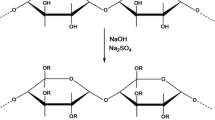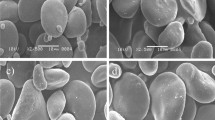Abstract
Effects of high hydrostatic pressure (HHP) and the propylene oxide (PO) concentration on the freeze-thaw stability, glass transition temperature (Tg′), and retrogradation degree of HHP-assisted hydroxypropylated corn starch were investigated. HHP-assisted hydroxypropylated corn starches were prepared using propylene oxide (4, 8, and 12%, v/w) at 25°C for 15 min under HHP (100, 200, 300, and 400 MPa). The freeze-thaw stability, Tg′, ice melting enthalpy (H i ), and retrogradation degree of HHP-assisted hydroxypropylated corn starches showed patterns different from native corn starch. In general, higher pressures and PO levels lowered Tg′ and H i values, and the retrogradation degree. The highest freeze-thaw stability was observed in HHP-assisted hydroxypropylated corn starch prepared using 12% PO at 400 MPa for 15 min. Retrogradation kinetics of hydroxypropylated corn starch gels observed from the glass transition temperature, ice melting enthalpy, and retrogradation degree revealed that recrystallization occurred with instantaneous nucleation, followed by rod-like growth of crystals.
Similar content being viewed by others

References
Osman EM. Starch in the food industry. Vol. II, pp. 163–210. In: Starch: Chemistry and Technology. Whistler RL, BeMiller JN, Paschall EF (eds). Academic Press, New York, NY, USA (1967)
Dias FF, Tekchandani HK, Mehta D. Modified starches and their use by food industries. Indian Food Ind. Mag 16: 33–39 (1997)
Pal J, Singhal RS, Kulkarni PR. A comparative account of conditions of synthesis of hydroxypropyl derivative from corn and amaranth starch. Carbohyd. Polym. 43: 155–162 (2000)
Shi X, BeMiller JN. Aqueous leaching of derivatized amylose from hydroxypropylated common corn starch granules. Starch-Stärke 54: 16–19 (2002)
Pal J, Singhal RS, Kulkarni PR. Physicochemical properties of hydroxypropyl derivative from corn and amaranth starch. Carbohyd. Polym. 48: 49–53 (2002)
B3aszczak W, Fornal J, Kiseleva VI, Yuryev VP, Sergeev AI, Sadowska J. Effect of high pressure on thermal, structural and osmotic properties of waxy maize and Hylon VII starch blends. Carbohyd. Polym. 68: 387–396 (2007)
Kim HS, Choi HS, Kim BY, Baik MY. Ultra high pressure (UHP)-assisted hydroxypropylation of corn starch. Carbohyd. Polym. 83: 755–761 (2011)
Choi HW, Lee JH, Ahn SC, Kim BY, Baik MY. Effects of ultra high pressure, pressure time and HCl concentration on non-thermal starch hydrolysis using ultra high pressure. Starch-Stärke 61: 334–343 (2009)
Lee JH, Choi HW, Kim BY, Chung MS, Kim DS, Choi SW, Lee DU, Park SJ, Hur NY, Baik MY. Nonthermal starch hydrolysis using ultra high pressure: I. Effects of acids and starch concentrations. LWT-Food Sci. Technol. 39: 1125–1132 (2006)
Hwang DK, Kim BY, Baik MY. Physicochemical properties of nonthermally cross- linked corn starch with phosphorus oxychloride using ultra high pressure (UHP). Starch-Stärke 61: 438–447 (2009)
Choi HS, Kim HS, Park CS, Kim BY, Baik MY. Ultra high pressure (UHP)-assisted acetylation of corn starch. Carbohyd. Polym. 78: 862–868 (2009)
Lim SS. Physicochemical properties of non-thermally dual modified corn starch using ultra high pressure (UHP). MS thesis, Kyung Hee University, Yongin, Korea (2011)
Kaur L, Singh N, Singh J. Factors influencing the properties of hydroxypropylated potato starches. Carbohyd. Polym. 55: 211–223 (2004)
Lawal OS. Starch hydroxyalkylation: Physicochemical properties and enzymatic digestibility of native and hydroxypropylated finger millet (Eleusine coracana) starch. Food Hydrocolloid. 23: 415–425 (2009)
Colwell KH, Axford DWE, Chamberlain N, Elton GAH. Effect of storage temperature on the aging of concentrated wheat starch gels. J. Sci. Food Agr. 20: 550–555 (1969)
Pongsawatmanit R, Temsiripong T, Ikeda S, Nishinari K. Influence of tamarind seed xyloglucan on rheological properties and thermal stability of tapioca starch. J. Food Eng. 77: 41–50 (2006)
Choi SG, Kerr WL. Effect of hydroxypropylation on retrogradation and water dynamics in wheat starch gels using 1H NMR. Cereal Chem. 80: 290–296 (2003)
Wattanachant S, Muhammad K, Hashim DM, Rahman RA. Effect of crosslinking reagents and hydroxypropylation levels on dualmodified sago starch properties. Food Chem. 80: 463–471 (2003)
Hoover R, Hannouz D, Ontario F, Sosulski F. Effects of hydroxypropylation on thermal properties, starch digestibility and freeze-thaw stability of field pea (Pisum sativum cv. Trapper) starch. Starch-Stärke 40: 383–387 (1998)
Perera C, Hoover R. Influence of hydroxypropylation on retrogradation properties of native, defatted and heat-moisture treated potato starches. Food Chem. 64: 361–375 (1999)
Wootton M, Manatsathit A. The influence of molar substitution on the water binding capacity of hydroxypropyl maize starches. Starch-Stärke 35: 92–94 (1983)
Gunaratne A, Corke H. Effect of hydroxypropylation and alkaline treatment in hydroxypropylation on some structural and physicochemical properties of heat-moisture treated wheat, potato and waxy maize starches. Carbohyd. Polym. 68: 305–313 (2007)
Koo HJ, Park SH, Jo JS, Kim BY, Baik MY. Gelatinization and retrogradation of 6-year-old Korean ginseng starches studied by DSC. LWT-Food Sci.Technol. 38: 59–65 (2005)
Baik MY, Kim KJ, Cheon KC, Ha YC, Kim WS. Recrystallization kinetics and glass transition of rice starch gel system. J. Agr. Food Chem. 45: 4242–4248 (1997)
Author information
Authors and Affiliations
Corresponding author
Rights and permissions
About this article
Cite this article
Chotipratoom, S., Choi, JH., Bae, JE. et al. Freeze-thaw stability, glass transition, and retrogradation of high hydrostatic pressure-assisted hydroxypropylated corn starch. Food Sci Biotechnol 24, 1327–1333 (2015). https://doi.org/10.1007/s10068-015-0170-4
Received:
Revised:
Accepted:
Published:
Issue Date:
DOI: https://doi.org/10.1007/s10068-015-0170-4



